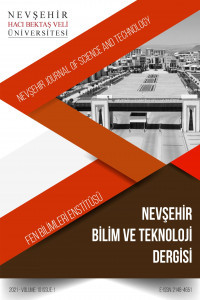Some Physical Properties of the Building Stones from Elazıg-Nevşehir Region
Körpe taşı, Nemrut taşı, Ürgüp taşı, Yeşilyurt taşı, yapı malzemesi
Elazığ - Nevşehir Bölgesinde Bulunan Yapı Taşlarının Bazı Fiziksel Özellikleri
Körpe taşı, Nemrut taşı, Yeşilyurt taşı, yapı malzemesi,
___
- Referans1. Devecioglu A.G., An investigation on the heat conduction parameters of porous building stones, Master Thesis, Firat University, 2001.
- Referans2. Bicer Y., Yildiz C., Pehlivan D., Some physical properties of the building stones from Mardin and Its Districts, TIEES-96 First Trabzon International Energy and Environment Symposium, July 29-31, Vol. 3, 1005-1009, July 29-31, Trabzon-Turkey, 1996.
- Referans3. Bicer Y., Devecioglu A.G, Akpinar E.K., Effective thermal conductivity of porous stones, Firat University Turkish Journal of Science & Technology, 15(4), 613-622, 2004.
- Referans4. TS 699, The test and experiment methods of natural building stones, TSE, Ankara, 1978
- Referans5. TS 500, Turkish Standard, Ankara, 2000.
- Referans6. Kaya A, Kar F., Properties of concrete containing waste expanded polystyrene and natural resin, Construction and Building Materials, 105, 572-578, 2016.
- Referans7. Kaya A, Kar F., Thermal and mechanical properties of gypsum plaster mixed with expanded polystyrene and tragacanth, Thermal Science and Engineering Progress, 1, 59-65, 2017.
- Referans8. Bicer A, Kar F., The effects of apricot resin addition to the light weight concrete with expanded polystyrene, Journal of Adhesion Science and technology, 31(21), 2335-2348, 2017.
- Referans9. Toksoy M., Endüstriyel malzemelerin ısıl iletkenlik katsayıları, T.M.M.O. Mühendis ve Makine Dergisi, 347, 12-15, 1988
- ISSN: 2148-466X
- Yayın Aralığı: Yılda 2 Sayı
- Başlangıç: 2012
- Yayıncı: Nevşehir Hacı Bektaş Veli Üniversitesi
Seryum Oksit Katkılı Doğal Obsidyen Camların Mekanik Özellikleri
Bülent AKTAŞ, Şerife YALÇIN, Abuzer AÇIKGÖZ, Rahime ŞERBETÇİ
Batch Reactor Design for Polystyrene Production
Nihayet Koçyigit, Necati Yalçın
Dental Uygulamalarda Kullanılan Biyomalzemeler
Duygu KIRKIK, Barış KARABULUT, Kübra ÖZTÜRK, Sevgi KALKANLI TAŞ
AHP ve DEMATEL Yöntemleri İle Nesnelerin İnternetinin İşletmelerde Yapılan Uygulamalarının Analizi
Rumeysa SAÇAK, Şeyda GÜR, Tamer EREN
Sağlık Alanında Kullanılan Biyomateryallerde Biyouyumluluk
Rahile ÖZTÜRK, Esra MALTAŞ ÇAĞIL
Mustafa Burak ÇOBAN, Hülya KARA SUBAŞAT
Some Physical Properties of the Building Stones from Elazıg-Nevşehir Region
Rize Kentsel Kıyı Şeridinin Kullanıcı Memnuniyetinin Belirlenmesi
